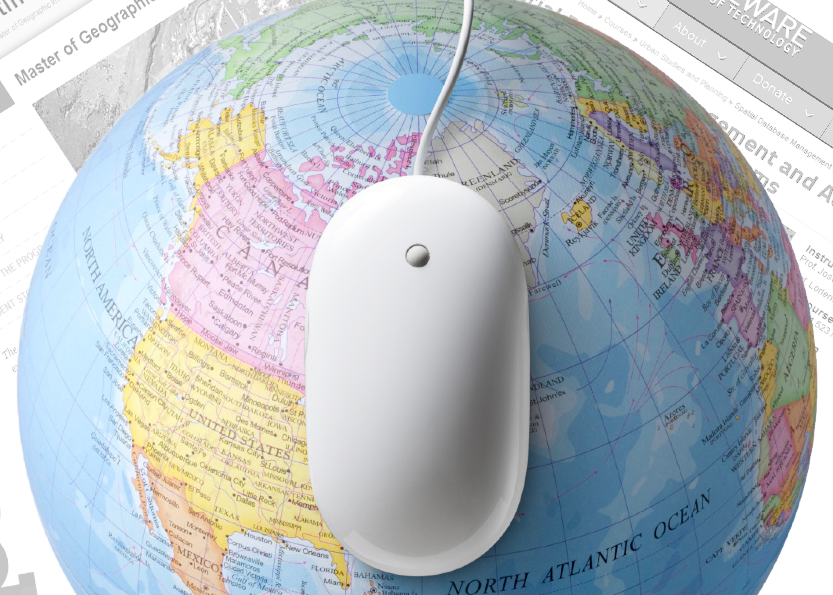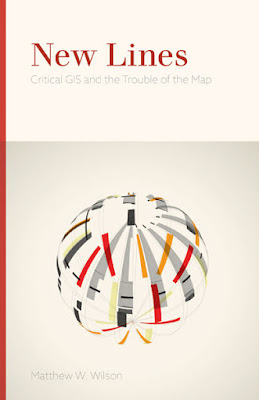Geospatial Education Online
Harvard hosted a conference on "Geospatial Technology and Online Education" last week, convened by David DiBiase (Esri). I moderated a panel on Geospatial Education Online. Below, I've provided the scope of the discussion and the preformed responses from the panelists.
Many higher education institutions now offer online courses, and in some cases complete online certificate and degree programs, focused on geospatial technologies and methods. Online geospatial programs tend to differ from their on-campus counterparts in various ways, including target audiences, educational objectives, business models, faculty composition, and others. Recently, the first geospatial MOOCs have shown potential to expand greatly public awareness of their relevance in society. The goal of this session is to take stock of the current status of geospatial education online and to consider its relationships with traditional programs on campus.
Panelists:
Adrienne Goldsberry, Michigan State
Karen Kemp, USC
Anthony Robinson, Penn State
Diana Sinton, UCGIS/Cornell
John Wilson, USC
Moderator:
Matthew W. Wilson, Harvard/U. of Kentucky
1. How might you summarize who we might want to reach with geospatial education offered online?
In the case of Michigan State University, we want to reach all MSU undergraduates and also working professionals from diverse backgrounds wanting to change or advance their careers by learning to think geographically and use geographic tools.
Adrienne Goldsberry
There are so many potential audiences, from on-campus traditional students to international working professionals, so my answer is “We want to reach everyone”.
Karen Kemp
Learner communities that include, but also spread far beyond the stereotypical campus cohort.
Anthony Robinson
We may want to reach every possibly interested person in the world, but while some are attempting that, it may be more strategic to aim for influential and powerful educational leaders and policy makers, whose knowledge of geography and geospatial matters may have the greatest effect.
Diana Sinton
Individuals interested in spatial thinking, analysis and mapping and all this entails given that timing is everything.
John Wilson
2. How might you summarize what we might want to accomplish with geospatial education offered online?
By taking an online geospatial course, we want students to develop - on their own time and at their own pace - a geographic perspective, and to learn how to apply that perspective using geographic tools.
Adrienne Goldsberry
Focusing only on professional education, we aim to ensure that users of geographic information technologies know both the technical skills and the fundamental theory so that they will be able to apply the technologies appropriately and effectively.
Karen Kemp
Develop connections to geography and spatial thinking among those who may not have ever previously considered the power of maps and spatial analysis.
Anthony Robinson
We want to engrain an understanding of the inherent power of geographically-based inquiry and reasoning, after we have expunged and overhauled the attitudes about what geography is as a subject of study.
Diana Sinton
Promote, encourage and empower spatial thinking across a range of disciplines and application domains.
John Wilson
3. How might you summarize what makes online geospatial education special/unique?
Its reliance on visualization, through objects like maps and satellite images, and digital tools, such as GIS and online mapping, to convey and analyze spatial relationships is uniquely suited for the visual consumption, manipulation, and analysis of information through a computer.
Adrienne Goldsberry
The dynamic nature of our science and technologies requires users to be independent, agile learners, a skill that is taught well in the on-line environment.
Karen Kemp
Learning in our field makes problem solving in other fields possible – but achieving that goal requires us to teach fundamental concepts in the context of a constantly-changing technology base.
Anthony Robinson
Online geospatial education is special because learners must disentangle multiple technologies and content while they find themselves in the unfamiliar landscape of geographical thinking.
Diana Sinton
Spatial science is an enabling discipline like statistics – hence a little bit (like creamer in coffee) makes lots of things work better.
John Wilson
4. How might you summarize the blurring of the distinction between professional and academic geospatial education online?
Teaching students to use and apply geospatial tools, such as GIS, GPS, and remote sensing, can sometimes (but not always!) overshadow teaching (and learning) the theory and concepts of the spatial relationships that these tools can analyze and represent.
Adrienne Goldsberry
I do not see it as a blurring, rather it is a rapid movement towards the professional end of the spectrum, towards applied practice and away deep scholarship.
Karen Kemp
I see a desirable shift away from old world dogma that says online education must only be applied and resident education must only focus on an academic perspective.
Anthony Robinson
Not blurring the distinction between professional and academic online geospatial education is largely anachronistic, unhelpful, and short-sighted, but this should not be conflated with the distinction between education and training, two still necessary but separate processes.
Diana Sinton
This is an opportunity to fix a longstanding problem because these should never have been separated in the first place.
John Wilson
Many higher education institutions now offer online courses, and in some cases complete online certificate and degree programs, focused on geospatial technologies and methods. Online geospatial programs tend to differ from their on-campus counterparts in various ways, including target audiences, educational objectives, business models, faculty composition, and others. Recently, the first geospatial MOOCs have shown potential to expand greatly public awareness of their relevance in society. The goal of this session is to take stock of the current status of geospatial education online and to consider its relationships with traditional programs on campus.
Panelists:
Adrienne Goldsberry, Michigan State
Karen Kemp, USC
Anthony Robinson, Penn State
Diana Sinton, UCGIS/Cornell
John Wilson, USC
Moderator:
Matthew W. Wilson, Harvard/U. of Kentucky
1. How might you summarize who we might want to reach with geospatial education offered online?
In the case of Michigan State University, we want to reach all MSU undergraduates and also working professionals from diverse backgrounds wanting to change or advance their careers by learning to think geographically and use geographic tools.
Adrienne Goldsberry
There are so many potential audiences, from on-campus traditional students to international working professionals, so my answer is “We want to reach everyone”.
Karen Kemp
Learner communities that include, but also spread far beyond the stereotypical campus cohort.
Anthony Robinson
We may want to reach every possibly interested person in the world, but while some are attempting that, it may be more strategic to aim for influential and powerful educational leaders and policy makers, whose knowledge of geography and geospatial matters may have the greatest effect.
Diana Sinton
Individuals interested in spatial thinking, analysis and mapping and all this entails given that timing is everything.
John Wilson
2. How might you summarize what we might want to accomplish with geospatial education offered online?
By taking an online geospatial course, we want students to develop - on their own time and at their own pace - a geographic perspective, and to learn how to apply that perspective using geographic tools.
Adrienne Goldsberry
Focusing only on professional education, we aim to ensure that users of geographic information technologies know both the technical skills and the fundamental theory so that they will be able to apply the technologies appropriately and effectively.
Karen Kemp
Develop connections to geography and spatial thinking among those who may not have ever previously considered the power of maps and spatial analysis.
Anthony Robinson
We want to engrain an understanding of the inherent power of geographically-based inquiry and reasoning, after we have expunged and overhauled the attitudes about what geography is as a subject of study.
Diana Sinton
Promote, encourage and empower spatial thinking across a range of disciplines and application domains.
John Wilson
3. How might you summarize what makes online geospatial education special/unique?
Its reliance on visualization, through objects like maps and satellite images, and digital tools, such as GIS and online mapping, to convey and analyze spatial relationships is uniquely suited for the visual consumption, manipulation, and analysis of information through a computer.
Adrienne Goldsberry
The dynamic nature of our science and technologies requires users to be independent, agile learners, a skill that is taught well in the on-line environment.
Karen Kemp
Learning in our field makes problem solving in other fields possible – but achieving that goal requires us to teach fundamental concepts in the context of a constantly-changing technology base.
Anthony Robinson
Online geospatial education is special because learners must disentangle multiple technologies and content while they find themselves in the unfamiliar landscape of geographical thinking.
Diana Sinton
Spatial science is an enabling discipline like statistics – hence a little bit (like creamer in coffee) makes lots of things work better.
John Wilson
4. How might you summarize the blurring of the distinction between professional and academic geospatial education online?
Teaching students to use and apply geospatial tools, such as GIS, GPS, and remote sensing, can sometimes (but not always!) overshadow teaching (and learning) the theory and concepts of the spatial relationships that these tools can analyze and represent.
Adrienne Goldsberry
I do not see it as a blurring, rather it is a rapid movement towards the professional end of the spectrum, towards applied practice and away deep scholarship.
Karen Kemp
I see a desirable shift away from old world dogma that says online education must only be applied and resident education must only focus on an academic perspective.
Anthony Robinson
Not blurring the distinction between professional and academic online geospatial education is largely anachronistic, unhelpful, and short-sighted, but this should not be conflated with the distinction between education and training, two still necessary but separate processes.
Diana Sinton
This is an opportunity to fix a longstanding problem because these should never have been separated in the first place.
John Wilson



Comments
Post a Comment